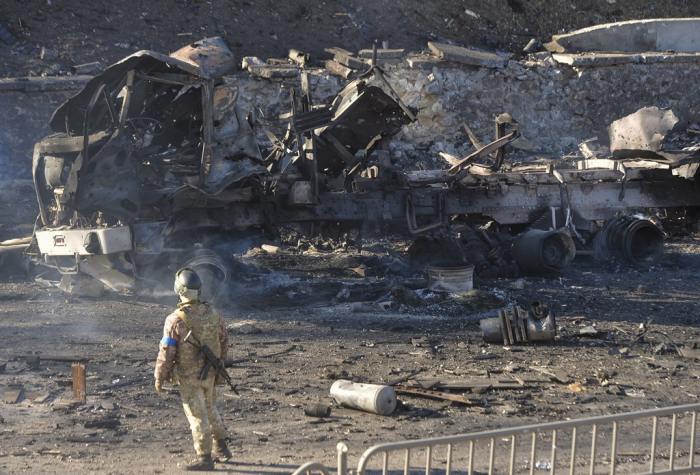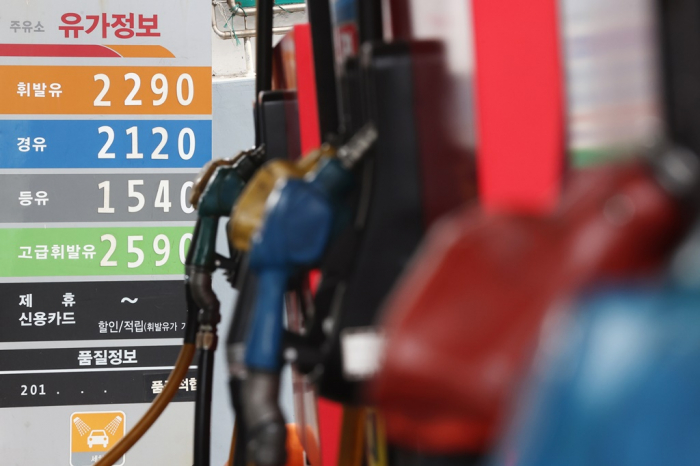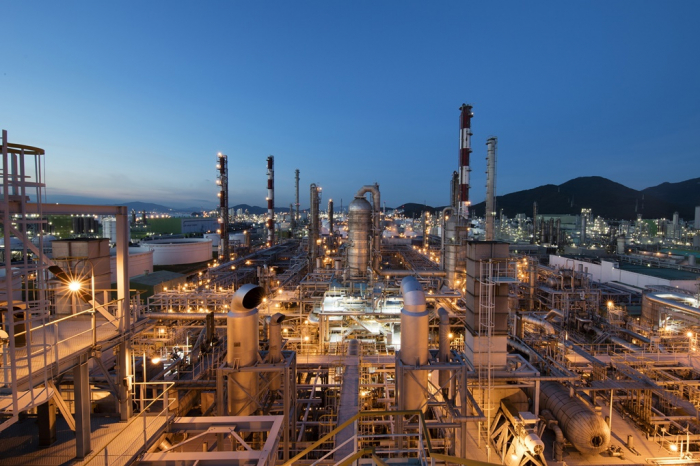War in Ukraine
Korean inflation fears grow amid Ukraine crisis
Petrochemical sector is expected to suffer more since Russia is top naphtha supplier; industry mulls more imports from Middle East
By Feb 28, 2022 (Gmt+09:00)
5
Min read
Most Read
Alibaba eyes 1st investment in Korean e-commerce platform


Blackstone signs over $1 bn deal with MBK for 1st exit in Korea


OCI to invest up to $1.5 bn in MalaysiaŌĆÖs polysilicon plant


Korea's Lotte Insurance put on market for around $1.5 bn


NPS loses $1.2 bn in local stocks in Q1 on weak battery shares



Fears are growing over accelerating inflation in South Korea as RussiaŌĆÖs invasion of Ukraine boosted energy and raw materials prices. The crisis is also expected to further disrupt the global supply chain. Some are concerned over potential stagflation in AsiaŌĆÖs fourth-largest economy already under pressure from rising prices amid increasing money supply.
Crude prices hovered around $100 a barrel after topping that level for the first time since 2014 following RussiaŌĆÖs military attack on Ukraine last week. The Dubai oil price, the benchmark of crude imported to South Korea, rose 12.9% on-month to $95.84 per barrel on Feb. 25, according to Korea National Oil Corp. The crude price has surged 46.6% from a year earlier. The price of Singapore 92 RON gasoline, motor fuel with 92% octane, surged to $114.33 a barrel on Feb. 24, the highest since July 2014. South KoreaŌĆÖs gasoline prices are linked to the Asian benchmark.
The Ukraine crisis is expected to raise other raw materials and grain prices, increasing upward pressure on South KoreaŌĆÖs inflation. The country, which is home to the worldŌĆÖs top two memory chipmakers ŌĆō Samsung Electronics Co. and SK Hynix Inc. ŌĆō relies on Ukraine and Russia for about half of its supplies of noble gases such as neon, krypton and xenon for semiconductor production.┬Ā
In addition, South KoreaŌĆÖs government was set to spend more with an extra budget of 16.9 trillion won ($14 billion) to support small companies and the self-employed while jeopardizing the central bankŌĆÖs efforts to stem inflation through interest rate hikes.
INFLATION MAY HEAD TO 4%
South Korea was not the only country to provide ample money worldwide. Such liquidity injection helped consumption recover when companies cut supplies due to COVID-19, ramping up prices.
The Bank of Korea last week raised its inflation forecast for this year to 3.1%, the highest since 2011 when consumer prices surged 4%, from the previous prediction of 2%.
Some experts, however, expected the countryŌĆÖs consumer prices to rise more than 4% in 2022, given surging oil prices.
ŌĆ£If oil prices rise above the $100 level, that will become another factor to raise prices. So, inflation could accelerate to 4%,ŌĆØ said Park Jung-soo, a professor at Sogang School of Economics.
Hyundai Research Institute predicted an average oil price of $100 a barrel to lift consumer inflation by 1.1 percentage points.

STAGFLATION?
Some experts flagged risks of stagflation ŌĆō rising inflation with slowing growth. Increasing costs could reduce production, which is likely to result in freezes or a cut in wages. But employees may demand higher salaries in line with rising inflation. That could create a vicious cycle since companies could raise product prices to reflect higher wages, intensifying inflationary pressure.
ŌĆ£It is hard to rule out worries about stagflation, given rising wages, when a supply shock has already lifted inflation expectations,ŌĆØ said Chang Yong-sung, a professor at the department of economics at Seoul National University.
The average monthly total wages for regular workers with employment contracts of more than one year rose 5% in the third quarter in 2021 from a year earlier, the largest growth since the first quarter of 2018, according to the Ministry of Employment and Labor. The growth is expected to rise further this year as major companies including Samsung Electronics and Kakao Corp. planned a hefty increase.
BOK Governor Lee Ju-yeol, however, dismissed worries about stagflation, saying an economic recession is a precondition of stagflation. ŌĆ£The economy will continue to grow above its potential growth not only this year but also the next.ŌĆØ
TO HIT PETROCHEMICAL SECTOR HARDER
Inflation hit the countryŌĆÖs industries across the board, especially the petrochemical sector.
Prices of naphtha, the feedstock of petrochemicals such as ethylene, surged 52% to $910.7 per ton on Feb. 25 from a year earlier, on surging oil prices.
The South Korean petrochemical industry suffered more since the country highly relies on Russia for the raw material. The country was South KoreaŌĆÖs largest naphtha supplier, providing about a quarter of the Asian countryŌĆÖs total requirements.
ŌĆ£We are preparing for the worst scenario, in which it becomes difficult to import naphtha from Russia,ŌĆØ said an industry source. ŌĆ£We are considering more purchases from the Middle East.ŌĆØ

A 10% rise in costs of import of naphtha and other raw materials is expected to raise prices of locally made petrochemicals by 1.4%, according to the Korea International Trade Association (KITA).
Rising liquefied natural gas prices also added to inflationary pressure since Russia, which produces 16.6% of the global natural gas production, is the worldŌĆÖs largest exporter of the energy resource. Higher liquefied natural gas prices often ramp up the costs of steelmakers that operate electric arc furnaces. LNG prices have jumped about 46% so far this month.
Other raw materials, especially ones for secondary batteries, also soared. Prices of nickel and aluminum, key ingredients of cathode materials, jumped more than a third compared to December 2021, respectively.
South Korean battery makers have few issues with those raw materials for now since they do not buy them much from Russia while procuring mostly from other countries through long-term contracts. But if the crisis lasts long, it will raise prices of those raw materials, batteries and electric vehicles, eventually, analysts said.
Write to Jin-gyu Kang, Ik-Hwan Kim, Ji-Hoon Lee and Jeong Min Nam at josep@hankyung.com
Jongwoo Cheon edited this article.
More to Read
-
 Business & PoliticsPerfect storm from Ukraine crisis clouds Korea Inc.ŌĆÖs outlook
Business & PoliticsPerfect storm from Ukraine crisis clouds Korea Inc.ŌĆÖs outlookFeb 25, 2022 (Gmt+09:00)
4 Min read -
 EconomyBOK sees inflation at 11-year high as oil tops $100 on Ukraine crisis
EconomyBOK sees inflation at 11-year high as oil tops $100 on Ukraine crisisFeb 24, 2022 (Gmt+09:00)
3 Min read -

-
 Banking & FinanceBOKŌĆÖs mission impossible: To lower both inflation and govt bond yields
Banking & FinanceBOKŌĆÖs mission impossible: To lower both inflation and govt bond yieldsFeb 15, 2022 (Gmt+09:00)
3 Min read -
 Banking & FinanceBOK restores interest rates to pre-pandemic level
Banking & FinanceBOK restores interest rates to pre-pandemic levelJan 14, 2022 (Gmt+09:00)
3 Min read -

Comment 0
LOG IN


